This past weekend I conducted a workshop in Corrales, New Mexico at the home of Nancy Freshour, an avid horsewoman. The three who participated were all accomplished horsewomen and really knew their horses well. 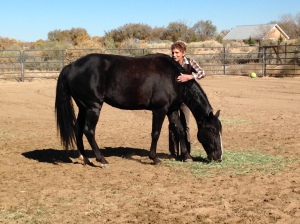 It was a joy for me to work with them on the foundations of liberty training, and watch how quickly the horses responded to the work. The horses we worked with all have very active lives – packing in the mountains, accompanying hunters carrying elk and deer out, clinic attendance, trail and ACTHA competition rides, you name it, they are doing it. Like all athletes, these horses are accustomed to “doing.” They know and enjoy their jobs and they do them well. The biggest shift seen in the clinic was that these horses learned that with liberty, they were not being asked to do anything at all except just be horses. It was sort of like being invited to a yoga or meditation class. Their owners and handlers were asked to simply be like them – in greeting, in movement, everything. In fact, their people would move them off their hay – just like another horse! What is happening here? The surprise on some of their faces was quite funny.
It was a joy for me to work with them on the foundations of liberty training, and watch how quickly the horses responded to the work. The horses we worked with all have very active lives – packing in the mountains, accompanying hunters carrying elk and deer out, clinic attendance, trail and ACTHA competition rides, you name it, they are doing it. Like all athletes, these horses are accustomed to “doing.” They know and enjoy their jobs and they do them well. The biggest shift seen in the clinic was that these horses learned that with liberty, they were not being asked to do anything at all except just be horses. It was sort of like being invited to a yoga or meditation class. Their owners and handlers were asked to simply be like them – in greeting, in movement, everything. In fact, their people would move them off their hay – just like another horse! What is happening here? The surprise on some of their faces was quite funny.
 One formerly abused Morgan mare, Willow, would not allow anyone to be behind her, but she might allow another horse behind her. This revealed that she was not viewing the movement that came from behind from a human as horse behavior, instead she felt it was predatory and threatening. We were able to work with her over the course of the workshop, and it was clear that she wanted to walk together side by side with us, no problem. From that we were able to achieve the “walking a horse down” foundational work. I was reminded of a comment made by Klaus Hempfling in a recent webinar, in which he said: “Horses feel they have to be the entire herd with humans….it’s exhausting.” That may be what this mare felt, that there was still a holdout in her mind, a place she could not allow the human to go for fear something would happen to her, so she had to take control.
One formerly abused Morgan mare, Willow, would not allow anyone to be behind her, but she might allow another horse behind her. This revealed that she was not viewing the movement that came from behind from a human as horse behavior, instead she felt it was predatory and threatening. We were able to work with her over the course of the workshop, and it was clear that she wanted to walk together side by side with us, no problem. From that we were able to achieve the “walking a horse down” foundational work. I was reminded of a comment made by Klaus Hempfling in a recent webinar, in which he said: “Horses feel they have to be the entire herd with humans….it’s exhausting.” That may be what this mare felt, that there was still a holdout in her mind, a place she could not allow the human to go for fear something would happen to her, so she had to take control.
This demonstrates to me just how far horses can be taken away from their natural relationship with humans. We all know of worse examples of this, but what is interesting is that this mare is a fully functioning member of society, so to speak. As a younger horse she threw three people and injured them. She was rescued by Nancy’s daughter and is an amazing trail horse. “Now we have a real horse who does parades, drill team, ponies, is excellent on the trail, and is willing to please,” said Nancy, although adding “she demonstrates the greatest fear and flight response,” so there was still a concern that she was not quite comfortable in her skin.
This work will help a horse like that get comfortable with difficult situations, and make her feel even more safe. What was also evident was that we couldn’t do a cooky cutter approach with her; we had to get creative. It wasn’t necessary that she learn the foundations in order; she learned them the way that best suited her. We had to be creative.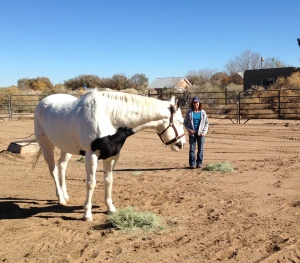
A visiting gelding who had to keep an eye on the goats was determined to stick by the hay, no matter what. We got him off the hay, with each person working with him, until he became softer in himself. He is a big 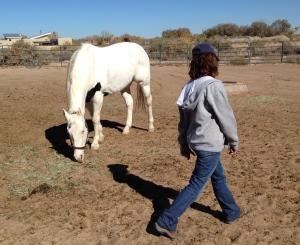 boy who uses his size to his advantage. He is very playful, looking to have a good time, but very smart and is on his way to knowing all the foundations. He demonstrated free longing beautifully.
boy who uses his size to his advantage. He is very playful, looking to have a good time, but very smart and is on his way to knowing all the foundations. He demonstrated free longing beautifully.
Aspen, Nancy’s Fox Trotter, was ready to do whatever she was asked (although she could be challenging), and was most surprised to find how easy the work was. Once she understood it, which was in a heartbeat, she moved into walking and trotting together, finishing off by showing how she could stand all four feet on a pedestal (Nancy taught her that!). 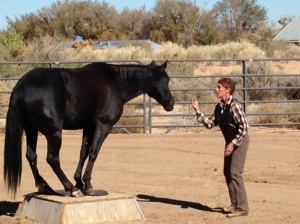 With these very accomplished horses and equestrians, the work demonstrated “the art of knowing horses.” Even when we know a lot about horses, have gathered a lifetime of knowledge, both deep and superficial, we can still know more, and will continue to know more as we keep our minds open to what they need from us. These horses do not have to feel they have to be “the entire herd” around people. They can be themselves and their people will find the best ways to make things happen for them. I will be conducting more of these small workshops while the weather allows and am considering a series during the spring, which would incorporate Open Bond (the work depicted in this blog), On Line and On Board work. Let me know if you would like to schedule one in your area.
With these very accomplished horses and equestrians, the work demonstrated “the art of knowing horses.” Even when we know a lot about horses, have gathered a lifetime of knowledge, both deep and superficial, we can still know more, and will continue to know more as we keep our minds open to what they need from us. These horses do not have to feel they have to be “the entire herd” around people. They can be themselves and their people will find the best ways to make things happen for them. I will be conducting more of these small workshops while the weather allows and am considering a series during the spring, which would incorporate Open Bond (the work depicted in this blog), On Line and On Board work. Let me know if you would like to schedule one in your area.
*****
Services: Bodywork (Ortho-Bionomy for people, Equine Positional Release/Equine Ortho-Bionomy): private sessions (including Horse & Rider sessions), tutorials, phone consultations, distance healing communication and gift certificates
Liberty Training: clinics, mini-clinics, workshops, private and semi-private sessions, tutorials, consultations: by appointment: 505.501.2478 or emailing susansmith@orthohorse.info Fall Lessons – semi-private, private and small group sessions. Scheduling now. We have small groups and privates scheduled for Santa Fe, Corrales and El Dorado currently. Contact me for details.
OrthoHorse Tutorials and Horses at Liberty Foundation Training Clinics will be offered on the 2014 schedule. Copyright (c) Susan Smith, OrthoHorse, Horses at Liberty Foundation Training



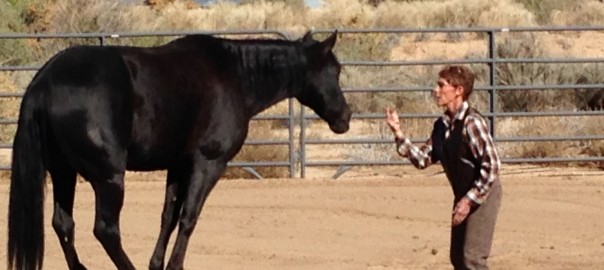
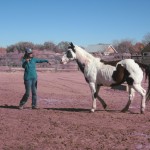
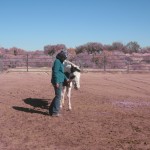
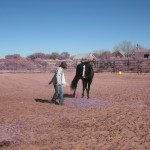
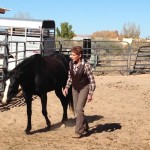
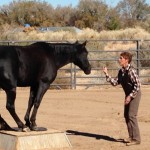
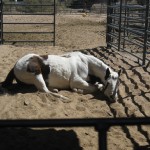
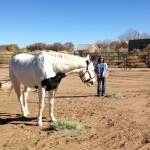
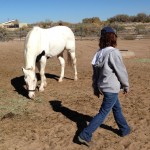
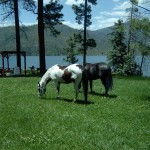
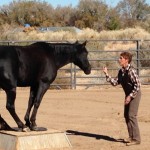
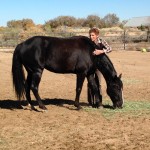
I got a paint mare from a lady who saved her from an auction in MO. She was so beaten by the cowboys that she collapsed in the sale pen. I brought he to Texas and worked with her to gain her trust, we hired a gentle expierenced trainer. He did get to her to where she would join up and was halterable, but ” Dunny ” (the mare) was never relaxed with it. I made the decision to turn her out with the other mares and let her enjoy life. 15mths ago when one of our broodmares was in the process of foaling, “Dunny” refused to follow the other mares into a lot, but she did surprise me and let me walk up to her and put a halter on her out in the 160 acres! It surprised everybody! She seems to not be so scared now (3Yrs later) I visit and check on them daily and she has occasionally let me pet her…but not much and not all over. I guess that I am going to start walking with the herd and see if that helps. I will sure get my exercise! Any suggestions would be appreciated!
Turning your mare out with the others was probably the best thing you could do, Moiselle. If you can sit with her and read a book or meditate, that will help her trust grow. Also holding your hand out to her in the way you see in my photos will demonstrate that you are greeting her the way the other horses do, although you’re not meeting nose to nose, but instead, hand to nose.